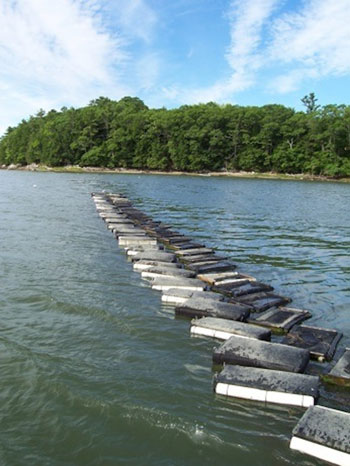Oysters Make Comeback on Damariscotta River
by Steve Cartwright

Oyster trays in the Damariscotta River. Growing oysters has been successful in this historically most productive area of the coast for wild oysters. Shellfish like oysters, mussels and clams thrive in the clean water they live in. Steve Cartwright photo
The Damariscotta River is famous for it’s massive oyster shell middens, but for more than a hundred years there were no oysters in the tidal estuary. Those shell heaps date back thousands of years, and are comprised almost entirely of oysters, five fathoms deep.
On the bottom, shells were up to 20 inches long. The Whaleback Midden measured 30 feet deep, more than 1,600 feet long and almost as wide as long. Even after tons of shells were mined for lime and chicken feed, vast mounds remain a short walk from Damariscotta’s downtown.
Those oyster shell heaps imply that aboriginal people feasted on this delicacy, then stopped, as layers of humus reveal lengthy time gaps between what appear to be three distinct groups of people savoring Damariscotta oysters. Mystery surrounds the earliest group of oyster feasters. After them came so-called prehistoric Red Paint people, then more recent Wabanaki tribes.
When Europeans invaded and settled the area in the 1700s, they built mills, shipyards and dams; they dumped waste in the water. The settlers clear-cut the banks of the river causing severe erosion. They muddied and dirtied the river, and before long, oysters had disappeared. Temperature shifts could also cause a die-off, but pollution seems the likely cause.
Today, that has dramatically changed. The waters are cleaner, perhaps warmer, and thanks to commercial oyster growing and the oyster’s prolific spawning, the wild American oyster is restored to the Damariscotta River.
The wild population is thriving, according to commercial harvesters, and a clammer can now make a living picking up oysters alongshore, no digging required.
The river has ideal oyster-growing conditions: the right level of salinity with a fresh water mix, warmer temperatures than the open sea. In the 1970s pioneer aquaculture entrepreneurs grew mussels and oysters in the river, helped by the University of Maine’s Ira C. Darling Center in Walpole, a research station on the river.
The Darling Center’s Prof. Herb Hidu encouraged anyone who would listen to grow oysters, and he influenced a generation of Maine aquaculturists, including the Pemaquid partners. Some of these sea farmers started with European oysters, then switched to growing American oysters, the native variety.
Dr. Chris Davis, U-Maine aquaculture instructor, was one of several pioneers of modern Maine oyster farming. A co-founder of Pemaquid Oyster Company in 1986, he remembers when there were virtually no wild oysters on the river. Now, he said, you can walk alongshore and pick them up – if you have a license to harvest them.
Jeff McKeen, a partner in Pemaquid Oyster Company, said the intertidal zone is thick with wild oysters; “there are places where you would shred your feet walking on oysters.” Wild oysters will even attach to the cultivated ones, he said. McKeen has been buying wild oysters from Dave Gilbert of Damariscotta, a life-long clam digger who has switched to gathering oysters in his hod.
McKeen handles marketing for the firm, and said wild oysters are now 5-10 percent of total shipments, he said. Oysters are shipped to wholesale brokers in Toronto, Philadelphia, Boston and New York. During the summer tourist season, Pemaquid sells cultivated oysters directly to a number of Maine restaurants.
Commercial oyster growing involves some 65 farms in Maine, and is estimated to have up to $5 million in landed value, according to Pemaquid Oyster’s Davis. He said that translates into $10-15 million in total economic activity. Oysters have been raised from the York River to Cutler - any tidal estuary can be a suitable site, he said.
In the early years, oyster growers dove for oysters or tried tongs to harvest them. Today, Davis said, the most efficient method is to drag for them. He believes dragging causes minimal disruption to the marine environment.
For years, Pemaquid Oyster Company has celebrated and promoted the oyster with a fall festival at Schooner Landing in Damariscotta village. Last year 18,000 oysters were shucked and served, on the half shell or in a stew. McKeen said some were farmed oysters, others harvested from the growing wild population.
This year’s oyster festival takes place Sunday, September 28.
You typically can hear music by McKeen and business partner Carter Newell, who have been playing music together even longer than they’ve been raising oysters.
